| Weight | 1 lbs |
|---|---|
| Dimensions | 9 × 5 × 2 in |
| host | mouse |
| isotype | IgG1 |
| clonality | monoclonal |
| concentration | concentrate, predilute |
| applications | IHC |
| reactivity | human |
| available size | 0.1 mL, 0.5 mL, 1 mL concentrated, 7 mL prediluted |
mouse anti-Steroidogenic Factor-1 (SF-1) monoclonal antibody (N1665) 6372
Price range: $160.00 through $528.00
Antibody summary
- Mouse monoclonal to Steroidogenic Factor-1 (SF-1)
- Suitable for: Immunohistochemistry (formalin-fixed, paraffin-embedded tissues)
- Reacts with: Human
- Isotype:IgG1
- Control: Adrenal cortical carcinoma
- Visualization: Nuclear
- 0.1, 0.5, 1.0 mL concentrated, 7 mL prediluted
mouse anti-Steroidogenic Factor-1 (SF-1) monoclonal antibody N1665 6372
| target relevance |
|---|
| Protein names Steroidogenic factor 1 (SF-1) (STF-1) (hSF-1) (Adrenal 4-binding protein) (Fushi tarazu factor homolog 1) (Nuclear receptor subfamily 5 group A member 1) (Steroid hormone receptor Ad4BP) |
| Gene names NR5A1,NR5A1 AD4BP FTZF1 SF1 |
| Protein family Nuclear hormone receptor family, NR5 subfamily |
| Mass 51636Da |
| Function FUNCTION: Transcriptional activator. Essential for sexual differentiation and formation of the primary steroidogenic tissues (PubMed:27378692). Binds to the Ad4 site found in the promoter region of steroidogenic P450 genes such as CYP11A, CYP11B and CYP21B. Also regulates the AMH/Muellerian inhibiting substance gene as well as the AHCH and STAR genes. 5'-YCAAGGYC-3' and 5'-RRAGGTCA-3' are the consensus sequences for the recognition by NR5A1 (PubMed:27378692). The SFPQ-NONO-NR5A1 complex binds to the CYP17 promoter and regulates basal and cAMP-dependent transcriptional activity. Binds phosphatidylcholine (By similarity). Binds phospholipids with a phosphatidylinositol (PI) headgroup, in particular PI(3,4)P2 and PI(3,4,5)P3. Activated by the phosphorylation of NR5A1 by HIPK3 leading to increased steroidogenic gene expression upon cAMP signaling pathway stimulation. {ECO:0000250|UniProtKB:P33242, ECO:0000269|PubMed:17210646, ECO:0000269|PubMed:27378692, ECO:0000269|PubMed:28459839}. |
| Subellular location SUBCELLULAR LOCATION: Nucleus {ECO:0000255|PROSITE-ProRule:PRU00407, ECO:0000269|PubMed:11479297, ECO:0000269|PubMed:27490115}. |
| Tissues TISSUE SPECIFICITY: High expressed in the adrenal cortex, the ovary, the testis, and the spleen (PubMed:9177385). {ECO:0000269|PubMed:9177385}. |
| Structure SUBUNIT: Binds DNA as a monomer. Interacts with NR0B2 and PPARGC1A (By similarity). Part of a complex consisting of SFPQ, NONO and NR5A1. Interacts with NCOA2. Interacts with DGKQ and CDK7. Binds to and activated by HIPK3. {ECO:0000250|UniProtKB:P33242, ECO:0000269|PubMed:11897684, ECO:0000269|PubMed:15707893, ECO:0000269|PubMed:15897460, ECO:0000269|PubMed:17210646, ECO:0000269|PubMed:17664281, ECO:0000269|PubMed:17901130}. |
| Post-translational modification PTM: Acetylation stimulates the transcriptional activity. {ECO:0000269|PubMed:11479297}.; PTM: Sumoylation reduces CDK7-mediated phosphorylation on Ser-203. {ECO:0000269|PubMed:15192080, ECO:0000269|PubMed:19015234}.; PTM: Phosphorylated on Ser-203 by CDK7. This phosphorylation promotes transcriptional activity. {ECO:0000269|PubMed:10230405, ECO:0000269|PubMed:17901130, ECO:0000269|PubMed:19015234}. |
| Involvement in disease DISEASE: 46,XY sex reversal 3 (SRXY3) [MIM:612965]: A condition characterized by male-to-female sex reversal in the presence of a normal 46,XY karyotype. {ECO:0000269|PubMed:10369247, ECO:0000269|PubMed:11932325, ECO:0000269|PubMed:17200175, ECO:0000269|PubMed:17694559, ECO:0000269|PubMed:24405868, ECO:0000269|PubMed:27378692, ECO:0000269|PubMed:27490115, ECO:0000269|PubMed:28459839}. Note=The disease is caused by variants affecting the gene represented in this entry.; DISEASE: 46,XX sex reversal 4 (SRXX4) [MIM:617480]: A condition in which male gonads develop in a genetic female (female to male sex reversal). {ECO:0000269|PubMed:27378692, ECO:0000269|PubMed:27490115, ECO:0000269|PubMed:27610946, ECO:0000269|PubMed:27855412}. Note=The disease is caused by variants affecting the gene represented in this entry.; DISEASE: Adrenal insufficiency, NR5A1-related (AINR) [MIM:612964]: A disorder characterized by adrenal insufficiency, muscular hypotonia, decreased sodium and increased potassium levels, elevated ACTH, salt-wasting crisis, prolonged jaundice, hypoglycemia, and vomiting. {ECO:0000269|PubMed:11038323, ECO:0000269|PubMed:26523528}. Note=The disease is caused by variants affecting the gene represented in this entry.; DISEASE: Premature ovarian failure 7 (POF7) [MIM:612964]: An ovarian disorder defined as the cessation of ovarian function under the age of 40 years. It is characterized by oligomenorrhea or amenorrhea, in the presence of elevated levels of serum gonadotropins and low estradiol. {ECO:0000269|PubMed:19246354}. Note=The disease is caused by variants affecting the gene represented in this entry.; DISEASE: Spermatogenic failure 8 (SPGF8) [MIM:613957]: An infertility disorder characterized by spermatogenesis failure and severe oligozoospermia. {ECO:0000269|PubMed:20887963}. Note=The disease is caused by variants affecting the gene represented in this entry. |
| Target Relevance information above includes information from UniProt accession: Q13285 |
| The UniProt Consortium |
Data
 |
| Human adrenal gland stained with anti-SF-1 antibody using peroxidase-conjugate and DAB chromogen. Note nuclear staining of cortical cells. |
Publications
| pmid | title | authors | citation |
|---|---|---|---|
| We haven't added any publications to our database yet. | |||
Protocols
| relevant to this product |
|---|
| IHC |
Documents
| # | SDS | Certificate | |
|---|---|---|---|
| Please enter your product and batch number here to retrieve product datasheet, SDS, and QC information. | |||
Only logged in customers who have purchased this product may leave a review.
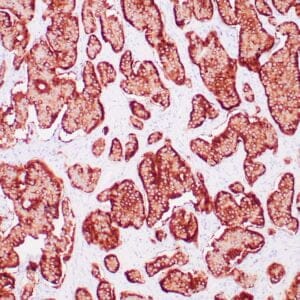
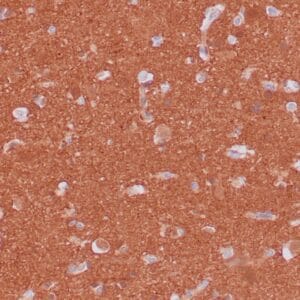
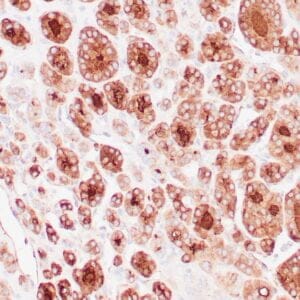
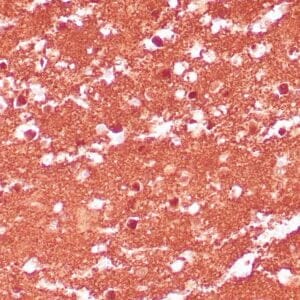
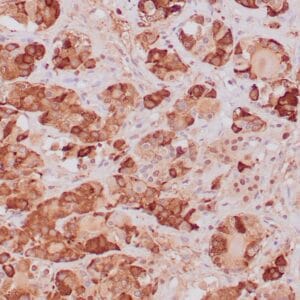
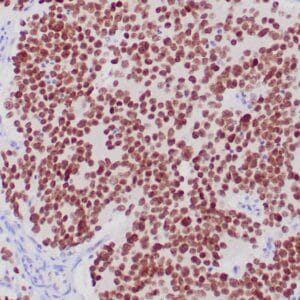

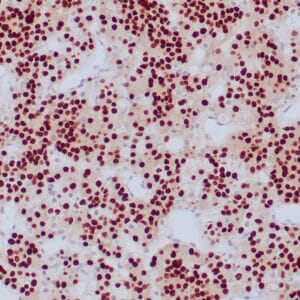
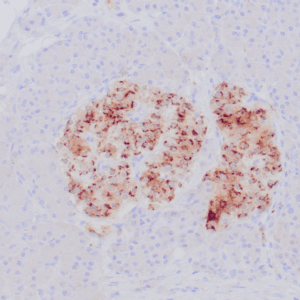
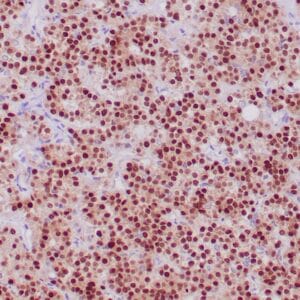
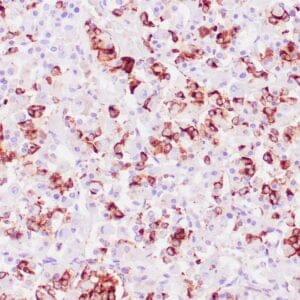

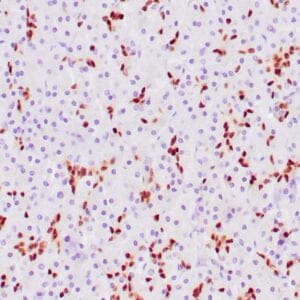
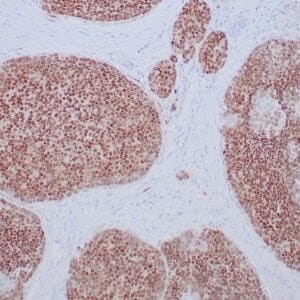
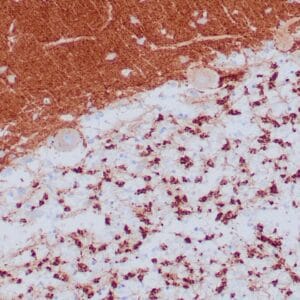
Reviews
There are no reviews yet.